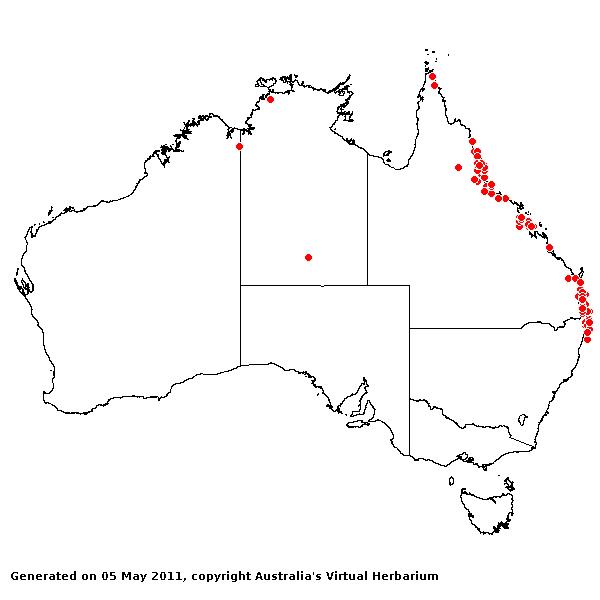Paspalum conjugatum* Berg. Acta
Helv. Phys.-Math .7:129 (1762).
Classification. (GPWG 2001) : Subfamily
Panicoideae. Paniceae.
Type of Basionym or
Protologue Information: LT: Rolander in Herb. Bergius 36, Surinam
(SBT). LT designated by Koning & Sosef, Blumea 30: 290, 293
(1985).
Key references
(books and floras): [2002] D.Sharp & B.K.Simon, AusGrass, Grasses of
Australia, [2008] S.W.L.Jacobs, R.D.B.Walley & D.J.B.Wheeler, Grasses
of New South Wales (327).
Illustrations:
[2008] S.W.L.Jacobs, R.D.B.Whalley & D.J.B.Wheeler, Grasses of New South
Wales, 4th edn (327).
Habit.
Perennial. Rhizomes present. Stolons present. Culms erect, 20–100 cm tall, 3–10
-noded. Mid-culm nodes glabrous. Lateral branches sparsely branched.
Leaf-sheath auricles absent. Ligule an eciliate membrane, 0.3–1.5 mm long.
Leaf-blades linear or lanceolate, 4–20 cm long, 5–15 mm wide. Leaf-blade
surface smooth, glabrous or indumented.
Inflorescence.
Inflorescence digitate, a panicle of racemes. Racemes 2–3, spreading, 4–17 cm
long, 0.8–1 mm wide, bearing 120–250 fertile spikelets on each.
Spikelets.
Spikelets sessile. Fertile spikelets 2-flowered, the lower floret barren
(rarely male), the upper fertile, comprising 1 basal sterile florets,
comprising 1 fertile floret(s), without rachilla extension, orbicular, dorsally
compressed, 1.2–1.8 mm long.
Glumes. Glumes
thinner than fertile lemma. Upper glume orbicular, 1.2–1.8 mm long, hyaline or
membranous, without keels, 2–3 -nerved. Upper glume surface glabrous. Florets.
Basal sterile florets 1, barren, without significant palea. Lemma of lower
sterile floret 100 % of length of spikelet, membranous, 2 -nerved.
Fertile lemma 1.2–1.8
mm long, without keel, 3 -nerved.
Continental
Distribution: Africa, Temperate Asia, Tropical Asia, Australasia, Pacific,
North America, and South America.
Australian
Distribution: Western Australia, Northern Territory, Queensland, New South
Wales, Christmas Is.
Western Australia:
Gardner. Northern Territory: Darwin & Gulf. Queensland: Cook,
Moreton, North Kennedy, Port Curtis, South Kennedy, Wide Bay. New South
Wales: North Coast.
Notes. A
morphologically very stable species which may result from a high dependence on
vegetative reproduction. Preferring wet roadsides or ditches and quickly
spreading via highly productive stolons.
A serious weed of
orchards, vineyards, sugarcane, lawns and golf courses. Moreover, the
stoloniferous plants trail in irrigation channels and reduce water flow. Poor
reputation as fodder, highly productive under good circumstances, suitable for
grazing only when young.
Introduced. In
tropical heaths, tropical and subtropical rain forests, and temperate rain
forests. Preferring wet roadsides or ditches and quickly spreading via highly
productive stolons. Flowers Apr.-Aug.





